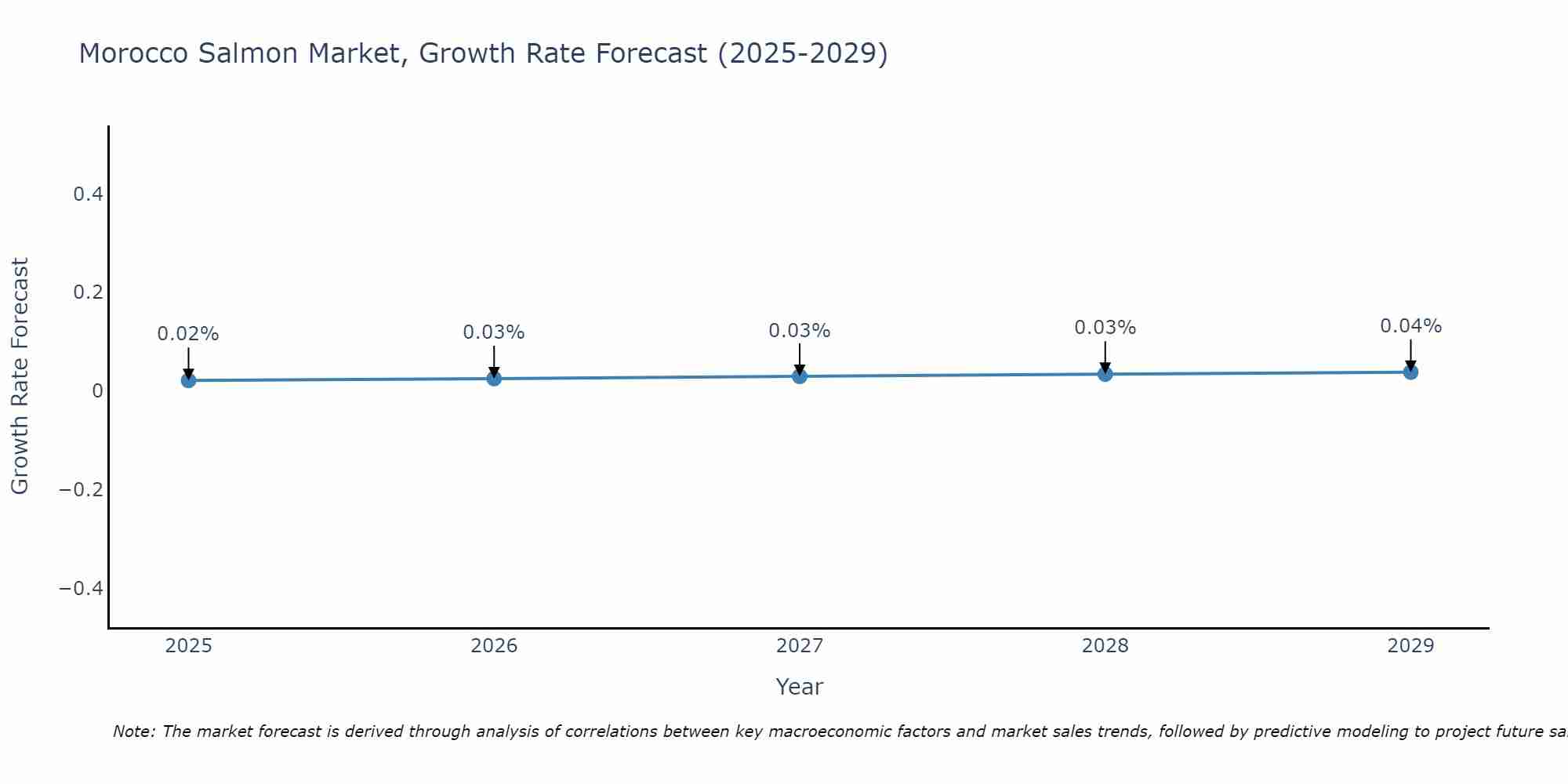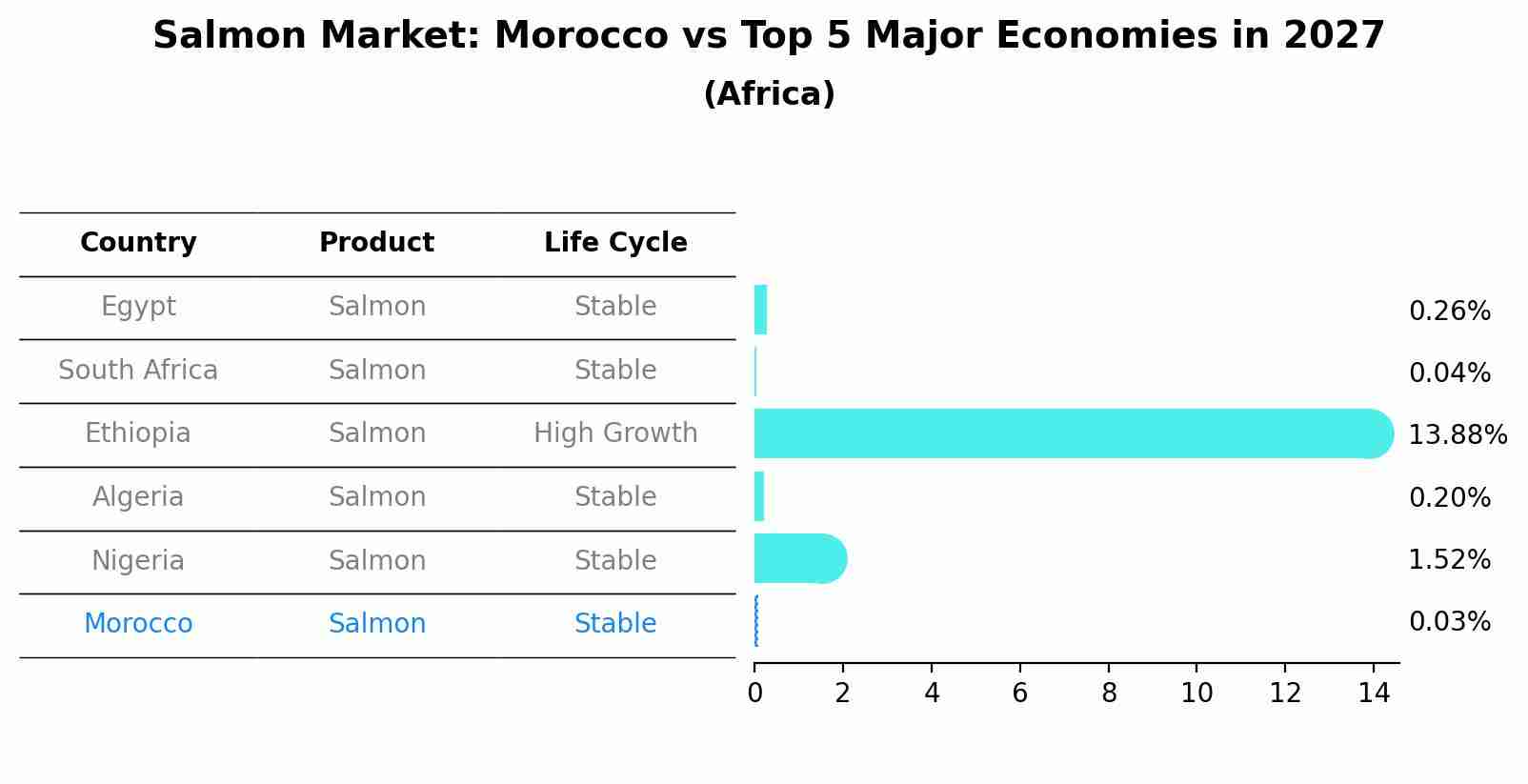Morocco Salmon Market (2025-2031) Outlook | Forecast, Companies, Share, Growth, Value, Trends, Analysis, Size, Revenue & Industry
| Product Code: ETC387653 | Publication Date: Aug 2022 | Updated Date: Jul 2025 | Product Type: Market Research Report | |
| Publisher: 6Wresearch | Author: Shubham Deep | No. of Pages: 75 | No. of Figures: 35 | No. of Tables: 20 |
Morocco Salmon Market Size Growth Rate
The Morocco Salmon Market is poised for steady growth rate improvements from 2025 to 2029. Commencing at 0.02% in 2025, growth builds up to 0.04% by 2029.

Salmon Market: Morocco vs Top 5 Major Economies in 2027 (Africa)
The Salmon market in Morocco is projected to grow at a stable growth rate of 0.03% by 2027, highlighting the country's increasing focus on advanced technologies within the Africa region, where Egypt holds the dominant position, followed closely by South Africa, Ethiopia, Algeria and Nigeria, shaping overall regional demand.

Morocco Salmon Market Synopsis
The salmon market in Morocco is experiencing steady growth due to increasing consumer demand for seafood products. The country primarily imports salmon from European countries such as Norway and Scotland to meet the demand. Moroccan consumers prefer fresh and high-quality salmon, often sourced from sustainable aquaculture practices. While salmon consumption is not as high compared to other seafood in Morocco, there is a growing trend towards incorporating salmon into the local cuisine and dining habits. The market is driven by factors such as rising disposable incomes, changing dietary preferences, and an overall shift towards healthier eating habits. As the market continues to evolve, there are opportunities for local aquaculture companies to expand production and cater to the increasing demand for salmon in Morocco.
Morocco Salmon Market Trends
The Morocco Salmon Market is experiencing growth due to increasing demand for healthy and high-protein food options among consumers. The market is witnessing a shift towards more sustainable and environmentally friendly practices, with a focus on responsible sourcing and production methods. There is also a trend towards value-added salmon products, such as smoked salmon and salmon fillets, catering to the preferences of convenience-seeking consumers. Additionally, the rising popularity of seafood consumption in Morocco, driven by health-conscious consumers and a growing middle-class population, is further fueling the growth of the salmon market. Overall, the Morocco Salmon Market is poised for continued expansion, driven by changing consumer preferences and a growing awareness of the health benefits of salmon consumption.
Morocco Salmon Market Challenges
In the Morocco Salmon Market, one of the main challenges faced is the competition from other established salmon-producing countries such as Norway and Chile. These countries have well-established salmon farming industries and strong brand reputation, making it difficult for Morocco to compete on a global scale. Additionally, the lack of domestic production infrastructure and technology in Morocco poses a challenge in terms of meeting the quality and quantity demands of the market. Issues related to sustainability and environmental concerns also impact the industry, as consumers are increasingly seeking responsibly sourced seafood products. Overall, the Morocco Salmon Market struggles with market penetration, technological limitations, and sustainability practices when compared to its global competitors.
Morocco Salmon Market Investment Opportunities
The Morocco Salmon Market presents lucrative investment opportunities due to increasing demand for salmon in the region driven by changing consumer preferences towards healthier protein sources. A key opportunity lies in the potential for expansion and modernization of salmon farming operations in Morocco to meet the growing demand both domestically and for export. Investing in technology and infrastructure improvements, sustainable farming practices, and market development initiatives can help capitalize on this trend. Additionally, strategic partnerships with international players in the salmon industry can provide access to expertise and global markets. Overall, investing in the Morocco Salmon Market offers the potential for long-term growth and profitability in a sector poised for further development and expansion.
Jordan Agar Market Government Policies
Government policies related to the Morocco Salmon Market include regulations on aquaculture operations, environmental protection, and export standards. The Moroccan government has implemented measures to ensure sustainable salmon farming practices, such as licensing requirements for aquaculture facilities and monitoring of water quality. Additionally, there are regulations in place to protect the natural environment and prevent pollution from salmon farming activities. Export standards focus on ensuring that Moroccan salmon meets international quality and safety requirements, allowing for market access to countries around the world. Overall, government policies aim to support the growth of the Morocco Salmon Market while promoting environmental sustainability and maintaining high product quality standards.
Morocco Salmon Market Future Outlook
The future outlook for the Morocco Salmon Market appears promising due to increasing consumer demand for seafood products, including salmon, driven by changing dietary preferences and a growing awareness of the health benefits associated with consuming seafood. Additionally, advancements in aquaculture technology and sustainable farming practices are expected to contribute to the growth of the salmon industry in Morocco. The country`s strategic geographical location provides access to key export markets in Europe and the Middle East, presenting opportunities for expansion and increased market share. However, challenges such as fluctuating global salmon prices, competition from other salmon-producing regions, and potential environmental concerns related to aquaculture practices may impact the market`s growth trajectory. Overall, the Morocco Salmon Market is poised for growth, supported by favorable market trends and industry developments.
Key Highlights of the Report:
- Morocco Salmon Market Outlook
- Market Size of Morocco Salmon Market, 2024
- Forecast of Morocco Salmon Market, 2031
- Historical Data and Forecast of Morocco Salmon Revenues & Volume for the Period 2021 - 2031
- Morocco Salmon Market Trend Evolution
- Morocco Salmon Market Drivers and Challenges
- Morocco Salmon Price Trends
- Morocco Salmon Porter's Five Forces
- Morocco Salmon Industry Life Cycle
- Historical Data and Forecast of Morocco Salmon Market Revenues & Volume By Type for the Period 2021 - 2031
- Historical Data and Forecast of Morocco Salmon Market Revenues & Volume By Chinook Salmon for the Period 2021 - 2031
- Historical Data and Forecast of Morocco Salmon Market Revenues & Volume By Coho Salmon for the Period 2021 - 2031
- Historical Data and Forecast of Morocco Salmon Market Revenues & Volume By Pink Salmon for the Period 2021 - 2031
- Historical Data and Forecast of Morocco Salmon Market Revenues & Volume By Red Salmon for the Period 2021 - 2031
- Historical Data and Forecast of Morocco Salmon Market Revenues & Volume By Salmo Salar for the Period 2021 - 2031
- Historical Data and Forecast of Morocco Salmon Market Revenues & Volume By Silverbrite Salmon for the Period 2021 - 2031
- Historical Data and Forecast of Morocco Salmon Market Revenues & Volume By End Product Type for the Period 2021 - 2031
- Historical Data and Forecast of Morocco Salmon Market Revenues & Volume By Fresh for the Period 2021 - 2031
- Historical Data and Forecast of Morocco Salmon Market Revenues & Volume By Frozen for the Period 2021 - 2031
- Historical Data and Forecast of Morocco Salmon Market Revenues & Volume By Canned for the Period 2021 - 2031
- Historical Data and Forecast of Morocco Salmon Market Revenues & Volume By Others for the Period 2021 - 2031
- Historical Data and Forecast of Morocco Salmon Market Revenues & Volume By Distribution Channel for the Period 2021 - 2031
- Historical Data and Forecast of Morocco Salmon Market Revenues & Volume By Retail Stores for the Period 2021 - 2031
- Historical Data and Forecast of Morocco Salmon Market Revenues & Volume By Hypermarket/supermarket for the Period 2021 - 2031
- Historical Data and Forecast of Morocco Salmon Market Revenues & Volume By Online Sales Channels for the Period 2021 - 2031
- Morocco Salmon Import Export Trade Statistics
- Market Opportunity Assessment By Type
- Market Opportunity Assessment By End Product Type
- Market Opportunity Assessment By Distribution Channel
- Morocco Salmon Top Companies Market Share
- Morocco Salmon Competitive Benchmarking By Technical and Operational Parameters
- Morocco Salmon Company Profiles
- Morocco Salmon Key Strategic Recommendations
Frequently Asked Questions About the Market Study (FAQs):
- Single User License$ 1,995
- Department License$ 2,400
- Site License$ 3,120
- Global License$ 3,795
Search
Thought Leadership and Analyst Meet
Our Clients
Related Reports
- Canada Oil and Gas Market (2026-2032) | Share, Segmentation, Value, Industry, Trends, Forecast, Analysis, Size & Revenue, Growth, Competitive Landscape, Outlook, Companies
- Germany Breakfast Food Market (2026-2032) | Industry, Share, Growth, Size, Companies, Value, Analysis, Revenue, Trends, Forecast & Outlook
- Australia Briquette Market (2025-2031) | Growth, Size, Revenue, Forecast, Analysis, Trends, Value, Share, Industry & Companies
- Vietnam System Integrator Market (2025-2031) | Size, Companies, Analysis, Industry, Value, Forecast, Growth, Trends, Revenue & Share
- ASEAN and Thailand Brain Health Supplements Market (2025-2031) | Strategy, Consumer Insights, Analysis, Investment Trends, Opportunities, Growth, Size, Share, Industry, Revenue, Segments, Value, Segmentation, Supply, Forecast, Restraints, Outlook, Competition, Drivers, Trends, Demand, Pricing Analysis, Competitive, Strategic Insights, Companies, Challenges
- ASEAN Bearings Market (2025-2031) | Strategy, Consumer Insights, Analysis, Investment Trends, Opportunities, Growth, Size, Share, Industry, Revenue, Segments, Value, Segmentation, Supply, Forecast, Restraints, Outlook, Competition, Drivers, Trends, Demand, Pricing Analysis, Competitive, Strategic Insights, Companies, Challenges
- Europe Flooring Market (2025-2031) | Outlook, Share, Industry, Trends, Forecast, Companies, Revenue, Size, Analysis, Growth & Value
- Saudi Arabia Manlift Market (2025-2031) | Outlook, Size, Growth, Trends, Companies, Industry, Revenue, Value, Share, Forecast & Analysis
- Uganda Excavator, Crane, and Wheel Loaders Market (2025-2031) | Strategy, Consumer Insights, Analysis, Investment Trends, Opportunities, Growth, Size, Share, Industry, Revenue, Segments, Value, Segmentation, Supply, Forecast, Restraints, Outlook, Competition, Drivers, Trends, Demand, Pricing Analysis, Competitive, Strategic Insights, Companies, Challenges
- Rwanda Excavator, Crane, and Wheel Loaders Market (2025-2031) | Strategy, Consumer Insights, Analysis, Investment Trends, Opportunities, Growth, Size, Share, Industry, Revenue, Segments, Value, Segmentation, Supply, Forecast, Restraints, Outlook, Competition, Drivers, Trends, Demand, Pricing Analysis, Competitive, Strategic Insights, Companies, Challenges
Industry Events and Analyst Meet
Whitepaper
- Middle East & Africa Commercial Security Market Click here to view more.
- Middle East & Africa Fire Safety Systems & Equipment Market Click here to view more.
- GCC Drone Market Click here to view more.
- Middle East Lighting Fixture Market Click here to view more.
- GCC Physical & Perimeter Security Market Click here to view more.
6WResearch In News
- Doha a strategic location for EV manufacturing hub: IPA Qatar
- Demand for luxury TVs surging in the GCC, says Samsung
- Empowering Growth: The Thriving Journey of Bangladesh’s Cable Industry
- Demand for luxury TVs surging in the GCC, says Samsung
- Video call with a traditional healer? Once unthinkable, it’s now common in South Africa
- Intelligent Buildings To Smooth GCC’s Path To Net Zero


















